A couple of reports last week reanimated the debate about what to do with Catholic schools, which have been hemorrhaging students for the last couple of decades. The new challenge—“one of their most complex… yet,” writes Sean Cavanagh in Education Week—is charter schools. One, by former RAND economist Richard Buddin, was published by the Cato Institute; the other, by Abraham Lackman, a scholar-in-residence at the Albany Law School, in Albany, New York, is not out yet, but was summarized by Cavanagh in the Ed Week story. Writes Cavanagh,
Many charter schools tout attributes similar to those offered by the church’s schools, such as disciplined environments, an emphasis on personal responsibility and character development, and distinctive instructional and curricular approaches.
And Buddin, whose report is more broadly aimed at measuring the impact of charters on all private schools, says,
[C]harter schools are pulling large numbers of students from the private education market and present a potentially devastating impact on the private education market, as well as a serious increase in the financial burden on taxpayers.
As both Adam Emerson and Kathleen Porter-Magee have already pointed out, Catholic schools were in decline long before charters came on the scene. Between 1960, when Catholics educated one out of every eight American school-age children (5.2 million) and 1990, when charter schools first came on the scene, 30 percent of the 13,000 Catholic schools in the U.S. closed (with enrollment plummeting to 2.5 million). In fact, since the pace of the enrollment decline has slackened in the charter era (2,000 of 9,000 schools—22 percent—have closed in the last 20 years) one might argue that charters have served as a wakeup call for Catholics. As Fordham’s 2008 report on Catholic schools showed, the nation’s largest religious denomination was taking steps to slow the decline; borrowing many of the tricks of the trade from charters, religious orders were forming the equivalent of CMOs, operating networks of schools, and doing sophisticated fundraising. And, as Cavanagh points out, the jury is still out on the benefits of voucher programs to Catholic schools.
As a Catholic, a former seminarian, and a journalist who has written about Catholic schools (here, here, and here), I must admit to being of two minds on the question of whether Catholic schools can be saved and whether their fate should be a public-policy issue. As to the latter, the argument that the public benefits from private schools by educating students that the taxpayer doesn’t have to is compelling. Lackman estimates that Catholic students moving to publicly financed charters in New York cost taxpayers an extra $320 million a year. Buddin says that, nationwide, the exodus costs $1.8 billion. Those are significant numbers. Does that mean the public should be subsidizing Catholic schools? Vouchers offer the cleaner—and Constitutional—public-policy option.
The question of what really ails Catholic schools is the one I would hope Catholics themselves continue to consider. Here, I would offer a couple avenues worth exploring. First, there’s the pedagogical and curricular problem. Here, John Dewey, no fan of the Catholics or their schools, which he pronounced “inimical to democracy,” may have had the last laugh: Once known for their rigorous academic and organizational structure, Catholic schools now implement many of the instructional theories and practices that predominate in Dewey-inspired progressive-education schools (the dominant principle of our public schools for most of the last fifty years). The other irony, as Tony Bryck and the co-authors of the now-classic 1992 study, Catholic Schools and the Common Good, discovered, is that by virtue of their rigor Catholic schools (once) did a better job educating ordinary kids, including the poor, than did public schools. As I wrote in my 2008 Ed Next story (referenced above),
According to the Common Good authors, Catholic high schools—and many believe that this applies to elementary schools as well—“manage simultaneously to achieve relatively high levels of student learning, distribute this learning more equitably with regard to race and class than in the public sector, and sustain high levels of teacher commitment and student engagement.” One of the keys, they concluded, is the organization of Catholic schools. Parochial schools are less likely to fall into the public-school habit of “structuring inequities”: public schools offer students the chance to take weaker academic courses while Catholic school courses are “largely determined by the school.” The irony, say Bryk et al., is that such a “constrained academic structure” contributes more to “the common school effect” than the potluck served by the public schools. Catholic schools give less weight to “background differences” of their students and thus do not allow those background differences to be “transformed into achievement differences.”
Thus, Catholic schools are simply not the academic hothouses they once were.
And Catholic schools may not be so Catholic anymore either. We know that the nuns, on whose back the system was built, according to Bryck et al, are largely gone, taking with them not just their free labor, but a zealous loyalty to “the faith.” The God gene has been modified. I recall an interview with a teacher at a Chicago charter school, started and run by the Christian Brothers, an ancient Catholic order, during which the teacher complained that the school’s problem was that it could not teach about God. He had a point. The seven pillars of character that hang from pretty banners in the hallway just don’t have the same resonance as the image of Moses coming down from the mountain with the ten commandments that God had just etched in stone tablets. (There is the old Catholic joke about the delinquent public school kid whose father transferred him to a Catholic school, where his misbehavior ceased. “I got there and saw this guy hanging from a tree with nails in his hands and feet,” the boy told his father, “and I figured they meant business.”)
The point is not that charters, which are public schools of course, need more religion—it’s that Catholic schools do. In their struggle to survive, parochial schools have opened their doors to students of all faiths and have, not surprisingly, watered down their evangelism. And while this has helped stem the tide of decline—as well as reinvigorate the church’s missionary zeal (the famous line from Cardinal Hickey of Washington, quoted by Kathleen, “we don’t education [urban] students because THEY are Catholic, but because WE are”)—it has also dampened the Church’s once-powerful religious belief system. It’s now hard to tell whether Church’s new ecumenical bent caused the decline in its schools or if the secularizing of the Catholic schools has made them less relevant—and less competitive. It may not be the Catholic school system that is in trouble, but the Church.
It may be well to ponder some history here and recall that the same 1884 conclave of Bishops (in Baltimore) that gave American Catholics a detailed “catechism” of belief was the same one that ordered each parish to build a school and each Catholic kid to attend it. Is it time for another such meeting?
-Peter Meyer
This blog entry originally appeared on the Fordham Institute’s Board’s Eye View blog.





